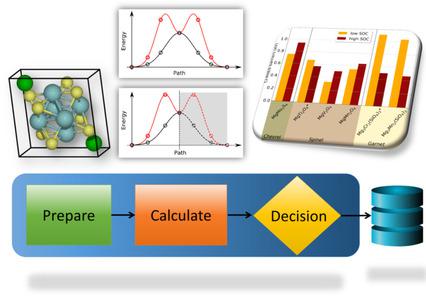当前位置:
X-MOL 学术
›
Batteries Supercaps
›
论文详情
Our official English website, www.x-mol.net, welcomes your feedback! (Note: you will need to create a separate account there.)
Autonomous Discovery of Materials for Intercalation Electrodes
Batteries & Supercaps ( IF 5.7 ) Pub Date : 2020-01-16 , DOI: 10.1002/batt.201900152 Felix T. Bölle 1 , Nicolai R. Mathiesen 1 , Alexander J. Nielsen 1 , Tejs Vegge 1 , Juan Maria Garcia‐Lastra 1 , Ivano E. Castelli 1
Batteries & Supercaps ( IF 5.7 ) Pub Date : 2020-01-16 , DOI: 10.1002/batt.201900152 Felix T. Bölle 1 , Nicolai R. Mathiesen 1 , Alexander J. Nielsen 1 , Tejs Vegge 1 , Juan Maria Garcia‐Lastra 1 , Ivano E. Castelli 1
Affiliation

|
The development of automated computational tools is required to accelerate the discovery of novel battery materials. In this work, we design and implement a workflow, in the framework of Density Functional Theory, which autonomously identifies materials to be used as intercalation electrodes in batteries, based on descriptors like adsorption energies and diffusion barriers. A substantial acceleration for the calculations of the kinetic properties is obtained due to a recent implementation of the Nudged Elastic Bands (NEB) method, which takes into consideration the symmetries of the system to reduce the number of images to calculate. We have applied this workflow to discover new cathode materials for Mg batteries, where two of these materials display a threefold increase in the potential of the Chevrel phase, the state‐of‐the‐art cathode in commercial prototype Mg batteries.
中文翻译:

自主发现嵌入电极的材料
需要开发自动计算工具来加速新型电池材料的发现。在这项工作中,我们在密度泛函理论的框架内设计和实现了一个工作流,该工作流根据诸如吸附能和扩散势垒等描述符,自动确定了用作电池中插入电极的材料。由于最近实施了微动松紧带(NEB)方法,从而大大提高了动力学性能的计算速度,该方法考虑了系统的对称性以减少要计算的图像数量。我们已应用此工作流程来发现用于镁电池的新型正极材料,其中两种材料显示出Chevrel相的电势增加了三倍,
更新日期:2020-01-16
中文翻译:

自主发现嵌入电极的材料
需要开发自动计算工具来加速新型电池材料的发现。在这项工作中,我们在密度泛函理论的框架内设计和实现了一个工作流,该工作流根据诸如吸附能和扩散势垒等描述符,自动确定了用作电池中插入电极的材料。由于最近实施了微动松紧带(NEB)方法,从而大大提高了动力学性能的计算速度,该方法考虑了系统的对称性以减少要计算的图像数量。我们已应用此工作流程来发现用于镁电池的新型正极材料,其中两种材料显示出Chevrel相的电势增加了三倍,


























 京公网安备 11010802027423号
京公网安备 11010802027423号